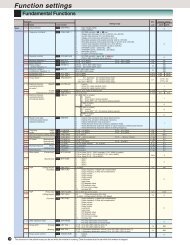Create successful ePaper yourself
Turn your PDF publications into a flip-book with our unique Google optimized e-Paper software.
14. Replacement Data<br />
When replacing the former inverters (VG, VG3, VG5) with VG7, please refer to this section.<br />
14.1 Classification of Replacement<br />
A: Both inverter and<br />
motor are replaced.<br />
B: Only the inverter is<br />
replaced.<br />
C: Only the motor is<br />
replaced.<br />
Inverter Motor Possibility<br />
VG5 ⇒ VG7S VG ⇒ VG7 Possible<br />
VG3/VG3N ⇒ VG7S VG3 ⇒ VG7 Possible<br />
VG5S/VG5N ⇒ VG7S<br />
VG5 ⇒ VG7<br />
(Same product)<br />
Possible<br />
VG5 ⇒ VG7S VG Possible (Note1)<br />
VG3/VG3N ⇒ VG7S VG3 Possible (Note1)<br />
VG5S/VG5N ⇒ VG7S VG5 Possible<br />
VG VG ⇒ VG7 Impossible (Note2)<br />
VG3 VG3 ⇒ VG7 Impossible (Note2)<br />
VG5<br />
VG5 ⇒ VG7<br />
(Same product)<br />
Possible<br />
Note 1: The rated current of VG and VG3 is bigger than that of VG5,VG7. For this reason, the inverter in<br />
one-rank upper grade is required if only the inverter is changed from VG or VG3.<br />
Note 2: For VG and VG3, the maximum output voltage, to which the stable current control is possible, is<br />
lower than that of VG5 and VG7. Therefore, if these inverters are combined with VG5 or VG7<br />
motors, the characteristics (torque accuracy or motor wow) at around the base speed or at higher<br />
speed will deteriorate.<br />
Note 3: Because the encoder pulse count of VG is 512P/R, operation is impossible if the VG7 motor<br />
encoder pulse count setting (P28) is different.<br />
14-1



